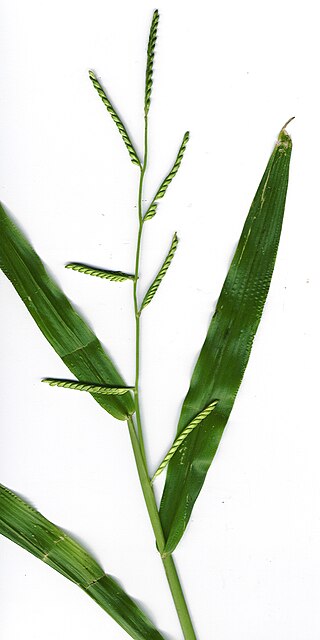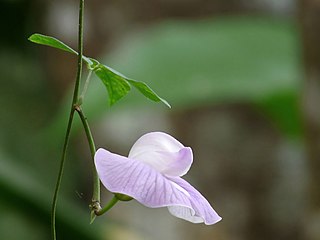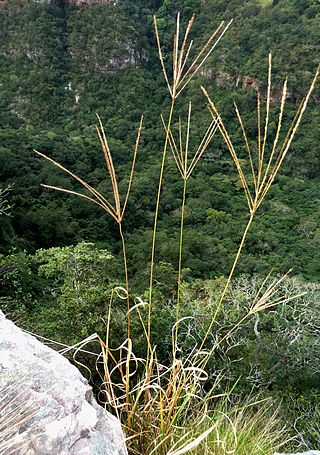Related Research Articles

Pasture is land used for grazing.

Forage is a plant material eaten by grazing livestock. Historically, the term forage has meant only plants eaten by the animals directly as pasture, crop residue, or immature cereal crops, but it is also used more loosely to include similar plants cut for fodder and carried to the animals, especially as hay or silage.

A legume is a plant in the family Fabaceae, or the fruit or seed of such a plant. When used as a dry grain, the seed is also called a pulse. Legumes are grown agriculturally, primarily for human consumption, for livestock forage and silage, and as soil-enhancing green manure. Well-known legumes include beans, soybeans, chickpeas, peanuts, lentils, lupins, grass peas, mesquite, carob, tamarind, alfalfa, and clover. Legumes produce a botanically unique type of fruit – a simple dry fruit that develops from a simple carpel and usually dehisces on two sides.

Trifolium repens, the white clover, is a herbaceous perennial plant in the bean family Fabaceae. It is native to Europe, including the British Isles, and central Asia and is one of the most widely cultivated types of clover. It has been widely introduced worldwide as a forage crop, and is now also common in most grassy areas of North America, Australia and New Zealand. The species includes varieties often classed as small, intermediate and large, according to height, which reflects petiole length. The term 'white clover' is applied to the species in general, 'Dutch clover' is often applied to intermediate varieties, and 'ladino clover' is applied to large varieties.

Panicum virgatum, commonly known as switchgrass, is a perennial warm season bunchgrass native to North America, where it occurs naturally from 55°N latitude in Canada southwards into the United States and Mexico. Switchgrass is one of the dominant species of the central North American tallgrass prairie and can be found in remnant prairies, in native grass pastures, and naturalized along roadsides. It is used primarily for soil conservation, forage production, game cover, as an ornamental grass, in phytoremediation projects, fiber, electricity, heat production, for biosequestration of atmospheric carbon dioxide, and more recently as a biomass crop for ethanol and butanol.

Vigna aconitifolia is a drought-resistant legume, commonly grown in arid and semi-arid regions of India. It is commonly called mat bean, moth bean, matki or dew bean. The pods, sprouts and protein-rich seeds of this crop are commonly consumed in India. Moth bean can be grown on many soil types, and can also act as a pasture legume.

Desmanthus is a genus of flowering plants in the mimosoid clade of the subfamily Caesalpinioideae of the pea family, Fabaceae. The name is derived from the Greek words δεσμός (desmos), meaning "bundle", and ἄνθος (anthos), meaning "flower". It contains about 24 species of herbs and shrubs that are sometimes described as being suffruiticose and have bipinnate leaves. Desmanthus is closely related to Leucaena and in appearance is similar to Neptunia. Like Mimosa and Neptunia, Desmanthus species fold their leaves in the evening. They are native to Mexico and North, Central and South America. Members of the genus are commonly known as bundleflowers. Donkey beans is another common name and originated in Central America, where Desmanthus species are highly regarded as fodder for these domestic draught animals.

Cytisus proliferus, tagasaste or tree lucerne, is a small spreading evergreen tree that grows 3–4 m (10–13 ft) high. It is a well known fertilizer tree. It is a member of the Fabaceae (pea) family and is indigenous to the dry volcanic slopes of the Canary Islands, but it is now grown in Australia, New Zealand and many other parts of the world as a fodder crop.

Chloris gayana is a species of grass known by the common name Rhodes grass. It is native to Africa but it can be found throughout the tropical and subtropical world as a naturalized species.

Brachiaria, or signalgrass, is a genus of plants in the grass family native to tropical and subtropical regions of Asia, Africa, Australia, southern Europe, the Americas, and various islands. There are over 100 species.
Bela "Bert" Grof was a Hungarian-born Australian agricultural researcher with contributions to grassland and forage research in the tropics.

Psathyrostachys juncea is a species of grass known by the common name Russian wildrye. It was formerly classified as Elymus junceus. It is native to Russia and China, and has been introduced to other parts of the world, such as Canada and the United States. Psathyrostachys juncea is a great source of food for grazing animals, as it has high nutrition value in its dense basal leaves, even in the late summer and autumn seasons. This species can grow and prosper in many harsh environments, making it an ideal candidate for improvement as it can grow in areas were farming is difficult. This species is a drought-resistant forage plant and can survive during the cool seasons. It is also a cross-pollinator and is self-sterile. This means that P. juncea cannot self-fertilize; it must find another plant of the same species with which to exchange gametes. Self-sterilization increases the genetic diversity of a species.
Derrick Thomas was a British agricultural researcher with special contributions to grassland and forage research in the tropics.

Urochloa brizantha is a species of grass known by the common name palisade grass. It is often used as a forage for livestock.

Alysicarpus vaginalis is a species of flowering plant in the legume family, Fabaceae. It is native to parts of Africa and Asia, and it has been introduced to other continents, such as Australia and the Americas. It is cultivated as a fodder for livestock, for erosion control, and as a green manure. Common names include alyce clover, buffalo clover, buffalo-bur, one-leaf clover, and white moneywort.

Centrosema pubescens, common name centro or butterfly pea, is a legume in the family Fabaceae, subfamily Faboideae, and tribe Phaseolae. It is native to Central and South America and cultivated in other tropical areas as a forage for livestock.

Chamaecrista rotundifolia, round-leaf cassia, also known as pasto rastiero, roundleaf sensitive pea, and Wynn cassia, is a short-lived perennial or self-generating annual plant in the subfamily Caesalpinioideae of the family Fabaceae. It originated in North America, Mesoamerica, the Caribbean, and Tropical South America but is grown in other parts of the world today. It grows in dry soils and areas of low rainfall, as well as in low-fertility and acidic soils with high levels of solubilized aluminum. It can also reduce erosion and runoff over time. These factors make it a potential asset to farmers in the African Subtropics and elsewhere where soil quality is a barrier to farming. It serves as a source of feed for livestock and acts as a green fertilizer, raising soil quality and nutrient content which can improve yields. These combined benefits make round-leaf cassia a potential solution to many problems faced by poor farmers and their communities.

Digitaria eriantha, commonly known as digitgrass or Pangola-grass, is a grass grown in tropical and subtropical climates. It grows relatively well in various soils, but grows especially well in moist soils. It is tolerant to droughts, water lodging, suppresses weeds and grows relatively quickly after grazing. This grass demonstrates great potential for farmers in Africa in subtropical and tropical climates, mostly for livestock feed.

Neustanthus is a monotypic genus of flowering plants belonging to the pea family Fabaceae and its tribe Phaseoleae. The only species is Neustanthus phaseoloides, called tropical kudzu. This species is a forage crop and cover crop used in the tropics. It is known as puero in Australia and tropical kudzu in most tropical regions.

Vigna trilobata, the African gram, three-lobe-leaf cowpea or jungle mat bean, is a regenerating annual herb found in India, Pakistan, Sri Lanka, Burma, Afghanistan and the Malay archipelago.
References
- 1 2 3 4 5 6 7 8 Schultze-Kraft, R; J.K. Teitzel (1992). "Brachiaria ruziziensis". Plant Resources of Southeast Asia (4): 65–67.
- 1 2 3 4 Silva, P; A. Martins (2013). "Development and validation of microsatellitte markers for Brachiaria ruziziensis obtained by partial genome assembly of illumine single-end reads". BMC Genomics. 14: 17. doi: 10.1186/1471-2164-14-17 . PMC 3565986 . PMID 23324172.
- ↑ Miles, J. W.; Maass, B. L.; do Valle, C. B., eds. (1996). Brachiara: biology, agronomy and improvement. ISBN 958-9439-57-8.
- 1 2 Heuzé V., Tran G., Boval M., Maxin G., Lebas F., 2017. Congo grass (Brachiaria ruziziensis). Feedipedia, a programme by INRA, CIRAD, AFZ and FAO.
- 1 2 Teixeria Resende, R; A. Auad (2012). "Impact of the Spittlebug Mahanarva spectabills on Signal Grass". Scientific World Journal. 2012: 1–6. doi: 10.1100/2012/926715 . PMC 3425814 . PMID 22927790.